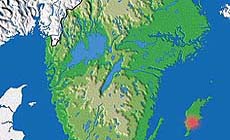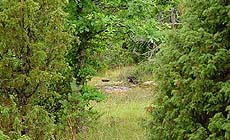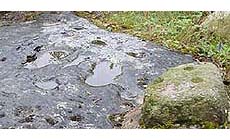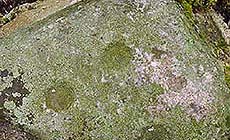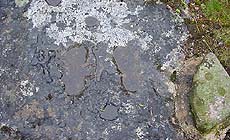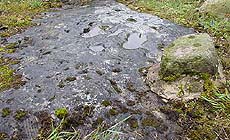|
|
 |
 |
Country: |
Sweden |
Locality: |
Bjerges i Lye |
|
 |
Region: |
Gotland |
Area: |
Lye |
|
 |
 |
|
|
|
|
| |
 |
Environment & Surface |
 |
 |
 |
|
Open-air
Shelter
Cave
Portable
Megalithic
|
Geography: |
Situated at the edge of a very wide flat rock surface in a clearing. Flat surface, with a once mobile upright small stone. Woodland. |
Proximity: |
Close to the sea, 1.1 km from road. Settlement. |
|
 |
Geology: |
Limestone. |
Surface: |
Flat, covered by moss and microflora. The rock with cup marks are loose, upright 20 cm from the ground, like a mushroom. |
|
Dimensions:
|
Length 0.50 m.
Width 0.40 m.
|
|
 |
 |
|
|
|
|
| |
 |
Art |
 |
 |
 |
Description: |
Engravings
Paintings
Painted engravings
High or low-relief
Sculpture
Bjerges, Lye, Gotland. Situated in a clearing in woodland. A small flat rock with 2 cup marks and 2 totally carved out foot prints placed in pair. Just beside the foot prints is a once mobile stone with 4 cup marks. The mobile rock has been moulded to the ground. The cup marks are quite deep and c. 5 cm diameter.
|
Figures: |
total number 8
2 foot prints
6 cup marks.
|
|
 |
Chronology: |
Palaeolithic
Epipalaeolithic - Mesolithic
Neolithic
Copper Age
Bronze Age
Iron Age
Roman
Middle Age
Modern
Unknown
The South Scandinavian rock carvings are usually dated to the middle and later part of the Bronze Age, c. 1500-500 BC, after Montelius six period system, but no detailed chronology can usually be worked out. When the carving is made on a mobile object, like a detached stone, the context of the find can sometimes give the carving a relatively detailed dating. Mobile stones with carvings have been found inside graves, and can be dated based on the finds from the grave. In Denmark and Norway, carvings of hands or feet on detached stones are quite common, and where the context are known and dated, typological and iconographical comparative analyses can be carried out as a relative dating method.
|
Notes: |
Only three carvings are known in Gotland at this date, In Hägvide, Lärbro parish, Bjerges in Lye and on the island of Fårö. And yet Gotland has an abundant Bronze Age culture. This could be because the limestone is soft and erodes easily, but it can also be that the Bronze Age culture in Gotland developed other ways for the ceremonial and ritual sphere. According to the legend, the foot prints in Bjerges are called "footprints of a Troll". A man were supposed to have been standing on the rock with soil in his shoes, caliming the land, and a witch was said to have been sitting at the mobile stone, milking a cow on the sly. Until recently people have been putting small offerings like coins or needles in the cup marks. |
|
 |
 |
|
| |
 |
Bibliography |
 |
|
|
|
|
| |
 |
Conservation |
 |
 |
 |
Status: |
Public
Private
Park
Classified site
|
Risk: |
The major risk for carvings are chemical weathering, which makes the hard quartzite losen up and fall out, leaving white dots on the darker rock surface. Also natural weathering (mechanical weathering) during winter/spring, when water freeze in cracks and openings in the rock, creates major damage to rock faces with carvings. The biological weathering is also a danger to the rock carvings, and even to intense cleaning of the rock surface during documentation can make the rock fragile and expose the carvings to wind, water and air-born pollution. The few carvings in Gotland have been carried out in limestone, and are subject to severe weathering. |
|
 |
Conservation: |
Good
Quite good
Mediocre
Bad
|
Intervention: |
Occasionally the rock surface are covered with earth and sand to prevent weathering. When there are animals causing damage, fences have being put up around the carved area, but not at this site. |
|
 |
 |
|
|
 |
By |
 |
|
| |
| Record n. 772 / 807 |
No commercial use is allowed. Specific © is mentioned in the captions or owned by each Author or Institution |
|
| |
 |
EuroPreArt, European Prehistoric Art, is a web-based archaeological project funded by the European Union which aims to establish a lasting data-base of European prehistoric art documentation, to launch the base of an European institutional network and to contribute to the awareness of the diversity and richness of European Prehistoric Art.
It is proposed by: Instituto Politécnico de Tomar (IPT, Portugal),
CUEBC - European University Centre for Cultural Heritage (Italy - Europe),
Consejo Superior de Investigaciones Científicas (España),
Asociación Cultural Colectivo Barbaón (España),
Université de Liège (Belgique),
Gotland University College (Sverige),
University College Dublin (Eire),
Cooperativa Archeologica Le Orme dell'Uomo (Italia),
Study Centre and Museum of Prehistoric Art of
Pinerolo (Italia),
The European Centre for Prehistoric Research in the Alto Ribatejo (Portugal),
ArqueoJovem - a youth NGO (Portugal).
|
|
|
|
 |
|
 NEW: Alpine rock paintings
NEW: Alpine rock paintings